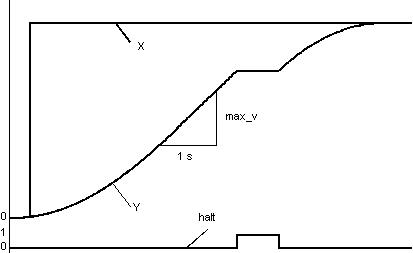The parameters for the function block can be set by determining the maximum velocity max_v and the maximum acceleration max_a. The maximum velocity specifies how much output Y can change within one second. The maximum acceleration specifies the maximum amount that output Y can change.
The value of Y follows the value of X, but is limited by the maximum permitted velocity and acceleration.
There are three operating mode selectable through the man and halt parameter inputs:
|
Operating mode
|
man
|
halt
|
Meaning
|
|
Automatic
|
0
|
0
|
A new value for Y will be constantly calculated and output.
|
|
Manual mode
|
1
|
0 or 1
|
The manual value YMAN will be transmitted fixed to the output Y.
|
|
Halt
|
0
|
1
|
The output Y will be held at the last calculated value. The output will no longer be changed, but can be overwritten by the user.
|
In the diagram the dynamic behavior of the function block is displayed as well as the reaction during HALT operating mode:
A jump on input X causes the function block to accelerate the increase of output Y. Output Y is accelerated using the value set for parameter max_a. Should the velocity reach the max_v value, acceleration stops, but output Y continues to follow input X with the maximum velocity max_v (see the straight section in the middle of the figure).
If the value of output Y is close enough to input signal value, the output is reversed to brake at a negative speed increase of -max_a, so that the output does not come to an abrupt stop, but slowly approximates the terminal point.
